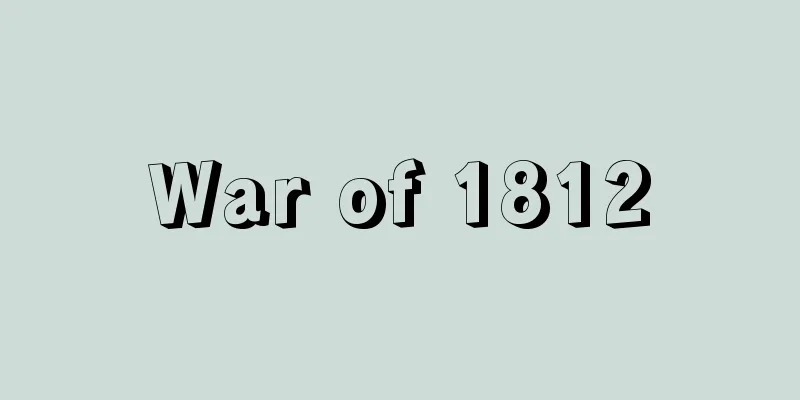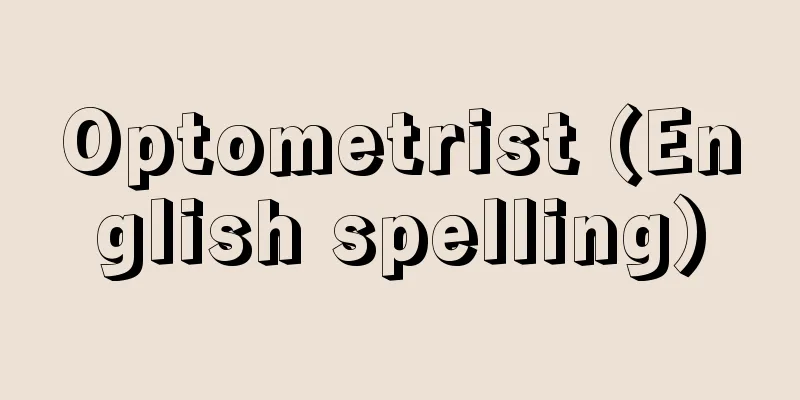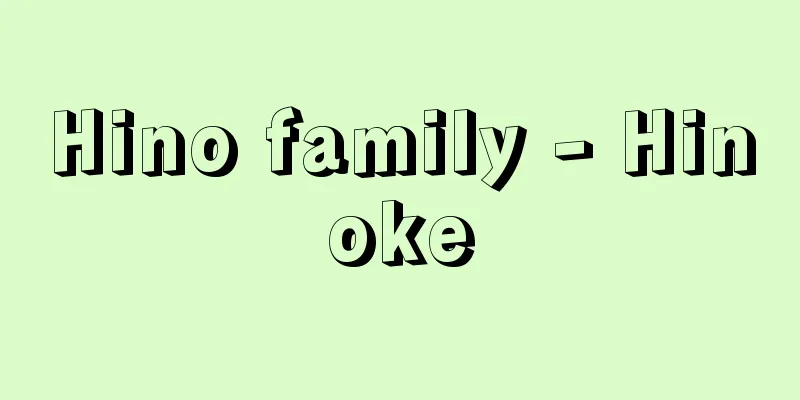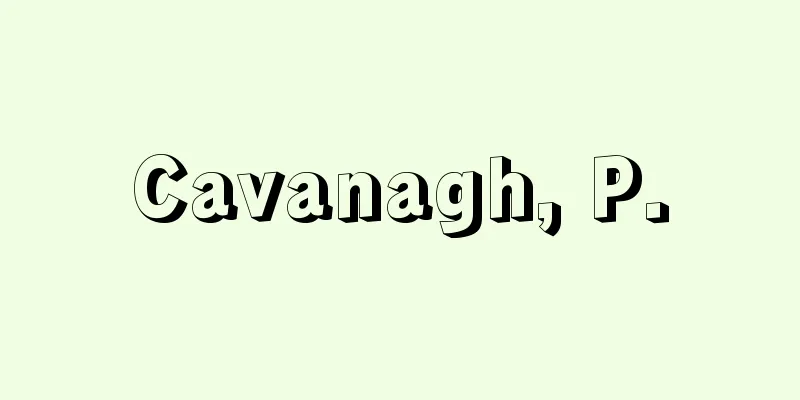Kindergarten - Kindergarten
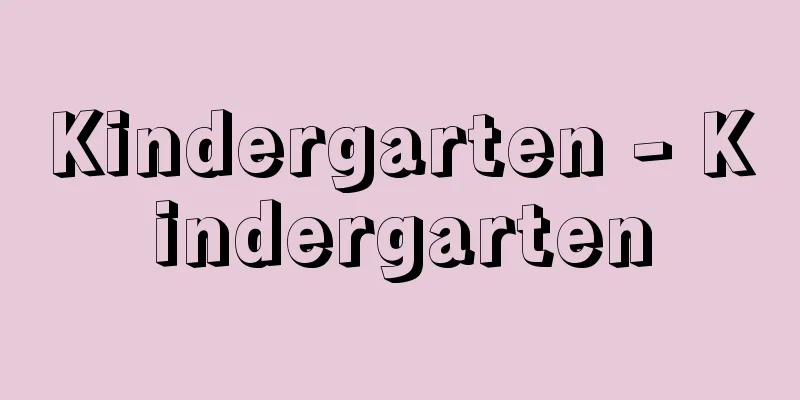
|
It is a school based on the School Education Act (Act No. 26 of 1947) and an educational and childcare facility based on the Child and Child-rearing Support Act (Act No. 65 of 2012). The curriculum and other childcare contents at kindergartens are stipulated in the Enforcement Regulations of the School Education Act and the Kindergarten Education Guidelines. [Mariko Miyata and Kiyomi Akita, April 18, 2018] The purpose and role of kindergartensArticle 1 of the School Education Act states that "In this Act, school means kindergarten, elementary school, junior high school, compulsory education school, high school, secondary education school, special needs school, university, and technical college," and kindergartens have a role as schools. They are for children from age 3 until the start of elementary school (Article 26 of the School Education Act). Parents who wish to enroll their children in a kindergarten apply and enter into a direct contract with the kindergarten operator. The purpose of kindergartens is stated in Article 22 of the School Education Act as "kindergartens are to nurture the foundations of compulsory education and subsequent education, to care for young children, to provide an appropriate environment for their healthy growth, and to promote their physical and mental development." Article 23 of the same act then sets out goals regarding health, human relationships, environment, language, and expression. Article 24 of the same act states that "kindergartens shall endeavor to support early childhood education in the home and the community." In order to achieve the goals set out in the School Education Act, there are the "Kindergarten Education Guidelines" which specify the purpose and content of childcare, and the "Kindergarten Establishment Standards" which set out the minimum standards for kindergarten operation and facilities when establishing a kindergarten. [Mariko Miyata and Kiyomi Akita April 18, 2018] Installation and operationEstablishment and abolition of kindergartens require permission from the prefectural board of education for public kindergartens and from the prefectural governor for private kindergartens (Articles 4 and 4-2 of the School Education Law). Regarding kindergarten facilities, Article 36 of the Enforcement Regulations of the School Education Law states that "In addition to the matters set out in this chapter, the facilities, organization and other matters relating to the establishment of kindergartens shall be governed by the Kindergarten Establishment Standards (Ministry of Education Ordinance No. 32 of 1956)," which stipulate the number of children per class (35 or less as a rule), class organization, teaching staff, and facilities. Article 37 of the Enforcement Regulations of the School Education Law states that "The number of weeks of education per school year at a kindergarten must not fall below 39 weeks, except in special circumstances," and the operation is stipulated in the ministerial ordinance. The Kindergarten Education Guidelines state that the standard number of hours of education per day is four hours. Article 27 of the School Education Act stipulates that kindergartens must have a principal, vice principal, and teachers, and Article 5 of the Kindergarten Establishment Standards stipulates that one teacher be assigned to each class. [Mariko Miyata and Kiyomi Akita April 18, 2018] Kindergarten teacherThe legal basis for kindergarten teachers is found in the School Education Act, the Educational Personnel Certification Act, and the Special Act on Educational Public Servants. Article 27, paragraph 9 of the School Education Act defines kindergarten teachers as "teachers shall be in charge of childcare for young children." Kindergarten teachers are trained in training courses at junior colleges or universities. Each training course grants different licenses, including specialized, first-class, and second-class licenses. Specialized licenses are awarded to those who have a master's degree, a first-class license is awarded to those who have a bachelor's degree, and a second-class license is awarded to those who have completed the required subjects stipulated in the respective licenses. [Mariko Miyata and Kiyomi Akita April 18, 2018] Origin and evolution as a school educationThe world's first kindergarten is said to be the Kindergarten opened by Friedrich Froebel in Bad Blankenburg, Germany in 1840. In Japan, the Education System promulgated in 1872 (Meiji 5) contained provisions for "yochishogaku" (early childhood education institutions), but none were opened. The first kindergarten in Japan is said to be the kindergarten attached to Tokyo Women's Normal School (now Ochanomizu University), which was established in 1876. This kindergarten was opened following the model of kindergartens in Europe and the United States in terms of its childcare operations and content. After that, practitioners and researchers of Japanese kindergarten education examined the efforts of affiliated kindergartens, and as a result, Japan's unique childcare content and methods were set out in the Kindergarten Education Guidelines. These became the guidelines for the operation of kindergartens that were opened thereafter. Furthermore, in the 2006 (Heisei 18) revision of the Fundamental Law of Education, a new provision on "Early Childhood Education" was added to Article 11. In the 2007 revision of the School Education Law, the order of the stipulations on school types was changed, and kindergartens, which had previously been placed at the end, are now placed before elementary schools as per the current Article 1. The subsequent 2008 revision of the Kindergarten Education Guidelines indicates the goal of education that cultivates the foundations for post-school education, as well as content that is conscious of cooperation and connections with elementary schools. The 2018 kindergarten education guidelines outline specific tasks for early childhood from three perspectives: (1) the foundations of knowledge and skills, (2) the foundations of thinking, judgment, and expression, and (3) the development of attitudes toward learning and humanity. They also outline 10 ideals for children to develop by the end of their early childhood years: (1) healthy mind and body, (2) independence, (3) cooperation, (4) the emergence of morality and awareness of norms, (5) involvement in social life, (6) the emergence of thinking ability, (7) involvement with nature and respect for life, (8) interest and sense for numbers, shapes, signs, letters, etc., (9) communication through words, and (10) rich sensitivity and expression. These 10 ideals are not set as goals to be achieved by the time children enter school, but are intended to be linked to the subsequent subject education in the elementary school curriculum. [Mariko Miyata and Kiyomi Akita April 18, 2018] Challenges and prospectsThe following three points are cited as challenges and prospects for kindergarten education. (1) Childcare for children aged 3 and after-school care Childcare for children aged 3 is when they enter kindergarten and receive care as soon as they turn 3 years old. This is a systemic practice stipulated in Article 26 of the School Education Act. Furthermore, in accordance with Article 24 of the School Education Act revised in 2006, which stipulates that kindergartens "shall endeavor to support early childhood in the home and community," kindergartens are permitted to admit 2-year-olds as part of their "child-rearing support activities." However, in fiscal year 2015, the number of 2-year-olds admitted to kindergartens was less than 10% of the number of 3-year-olds admitted, and utilization is limited. Issues include securing classrooms and caregivers for this purpose, and how to improve the qualifications of caregivers, such as knowledge and skills regarding care for 2-year-olds and 3-year-olds. After-school care is childcare provided to those who wish to receive it after regular kindergarten education. The number of users is increasing year by year. Issues include securing childcare rooms and caregivers, and improving the expertise in the care and education of children who receive long hours of childcare. (2) Guidance for children who require special consideration This was added to the kindergarten education guidelines for fiscal year 2018. It refers to the support for children with disabilities, children who have returned from overseas, and children who have difficulty learning Japanese. (3) Improving the quality of kindergarten education Educational scholar Takashi Muto (1946-) lists three future issues for improving the quality of early childhood education: (1) fostering independent and interactive learning in early childhood, (2) improving the curriculum and evaluation, and (3) creating and establishing a system for external guidance, such as early childhood education centers and early childhood education advisors. In addition, he lists the following as the form of training for childcare workers that is necessary for such quality improvement: (1) institutionalization, (2) careerization, and (3) networking. [Mariko Miyata and Kiyomi Akita April 18, 2018] "Ministry of Education, Culture, Sports, Science and Technology, 'Elementary Education Materials' July Special Issue (2017, Toyokan Publishing)" [References] | | | |Source: Shogakukan Encyclopedia Nipponica About Encyclopedia Nipponica Information | Legend |
|
学校教育法(昭和22年法律第26号)に基づく学校であり、また子ども・子育て支援法(平成24年法律第65号)に基づく教育・保育施設。幼稚園における教育課程とその他の保育内容については、学校教育法施行規則と幼稚園教育要領に定められている 幼稚園の目的および役割学校教育法第1条に、「この法律で、学校とは、幼稚園、小学校、中学校、義務教育学校、高等学校、中等教育学校、特別支援学校、大学及び高等専門学校とする」とあり、幼稚園には学校としての役割がある。対象は、満3歳から小学校就学の始期に達するまでの幼児である(学校教育法第26条)。入園を希望する保護者が申請し、幼稚園設置者と直接契約を結ぶ。幼稚園の目的は、学校教育法第22条にある「幼稚園は、義務教育及びその後の教育の基礎を培うものとして、幼児を保育し、幼児の健やかな成長のために適当な環境を与えて、その心身の発達を助長すること」である。続く同法第23条において、健康、人間関係、環境、ことば、表現に関する目標が掲げられている。そして同法第24条には「家庭及び地域における幼児期の教育の支援に努めるものとする」とある。これら学校教育法において定められた目標の実現のために、より具体的に目的や保育内容が書かれたものとして「幼稚園教育要領」が、幼稚園設置にあたり、園の運営や設備に関して必要最低の基準を示した「幼稚園設置基準」などがある。 [宮田まり子・秋田喜代美 2018年4月18日] 設置・運営幼稚園の設置廃止等は、公立は都道府県教育委員会、私立は都道府県知事の許可を得なければならない(学校教育法第4条、第4条の2)。幼稚園の施設設備については、学校教育法施行規則第36条に「幼稚園の設備、編制その他設置に関する事項は、この章に定めるもののほか、幼稚園設置基準(昭和三十一年文部省令第三十二号)の定めるところによる」とあり、幼稚園設置基準には、一学級の幼児数(35人以下を原則とする)や学級の編制、教職員、施設設備に関する基準が定められている。学校教育法施行規則第37条には「幼稚園の毎学年の教育週数は、特別の事情のある場合を除き、三十九週を下つてはならない」とあり、省令においてその運営を定めている。幼稚園教育要領において、一日の教育時間は標準を4時間としている。職員は、学校教育法第27条において、園長、教頭、教諭が必置とされており、幼稚園設置基準第5条において、学級ごとに1名の教員を配置することになっている。 [宮田まり子・秋田喜代美 2018年4月18日] 幼稚園教諭幼稚園教諭の法的根拠は、学校教育法、教育職員免許法、教育公務員特例法にある。学校教育法第27条9項には、「教諭は、幼児の保育をつかさどる」と定義されている。幼稚園教諭は、短期大学や大学の養成課程において養成される。各養成課程において付与される免許状は異なっており、専修、一種、二種がある。専修免許状は修士の学位、一種は学士の学位、二種は短期大学士の称号を取得し、それぞれの免許状に定められた所定の科目を修得した者に与えられる。 [宮田まり子・秋田喜代美 2018年4月18日] 起源と学校教育としての変遷世界で最初の幼稚園は、1840年にフリードリッヒ・フレーベルがドイツのバートブランケンブルクで開設したKindergarten(キンダーガルテン)であるとされている。日本では、制度的には1872年(明治5)公布の「学制」のなかに、幼児教育機関としての「幼稚小学」の規定があるが開設には至っていない。日本で最初の幼稚園は、1876年にできた東京女子師範学校(現、お茶の水女子大学)附属幼稚園とされている。この幼稚園は、保育の運営、内容などを欧米の幼稚園に倣う形で開設された。その後、日本の幼稚園教育の実践者や研究者らによって附属幼稚園の取り組みが検討された結果、日本独自の保育内容や方法等が幼稚園教育要領によって示された。これがその後開設された幼稚園の運営の指針となっている。 また2006年(平成18)改正の教育基本法には第11条に「幼児期の教育」が新設された。2007年改正の学校教育法においては、学校種の規定順が変更され、それまでは最後に置かれていた幼稚園が、現行第1条にあるように小学校の前に位置づけられるものとなった。そしてその後の2008年改訂幼稚園教育要領では、就学後の教育の基礎を培う教育としての目標や小学校との連携や接続を意識した内容が示されている。平成30年度幼稚園教育要領では、〔1〕知識及び技能の基礎、〔2〕思考力、判断力、表現力等の基礎、〔3〕学びに向かう力、人間性等を育む三つの視点からの幼児期における具体的課題と、「幼児期の終わりまでに育ってほしい姿」として10の姿、(1)健康な心と体、(2)自立心、(3)協同性、(4)道徳性・規範意識の芽生え、(5)社会生活との関わり、(6)思考力の芽生え、(7)自然との関わり・生命尊重、(8)数量や図形、標識や文字などへの関心・感覚、(9)言葉による伝え合い、(10)豊かな感性と表現、を幼稚園修了時の具体的な姿として示している。これら10の姿は就学までの到達目標として設定されるのではなく、続く小学校課程での教科教育につなげられるものであるとされている。 [宮田まり子・秋田喜代美 2018年4月18日] 課題と展望幼稚園教育における課題と展望として以下三つをあげる。 (1)満3歳児保育と預かり保育 預かり保育は、通常の幼稚園教育の後に希望者に向けて実施されている保育のことである。利用者は年々増加している。保育室と保育者の確保と長時間保育を受ける子どもへのケアと教育に対する専門性の向上が課題となっている。 (2)特別な配慮を必要とする幼児への指導 (3)幼稚園教育の質の向上 [宮田まり子・秋田喜代美 2018年4月18日] 『文部科学省編『初等教育資料』7月号臨時増刊(2017・東洋館出版社)』 [参照項目] | | | |出典 小学館 日本大百科全書(ニッポニカ)日本大百科全書(ニッポニカ)について 情報 | 凡例 |
<<: Infant industry - yochisangyō (English spelling)
Recommend
Taila II (English name)
...The next king, Vikramaditya II, occupied the P...
Control - to control
〘Tasahen〙 Sei・su 〘Tasahen〙① To decide rules and th...
Subtropical - Anetta
The northern and southern hemispheres of the Eart...
Clam shrimp (shell shrimp) - Clam shrimp (English spelling)
A small freshwater crustacean with a shell similar...
Ozu paper - Ozu paper
〘Noun〙 A type of writing paper produced in the Ozu...
Satto-ra
A Chinese poet from the late Yuan Dynasty. His pe...
deAndrea, J.
…It was produced mainly in the United States and ...
Chios - Chios
...It is rich in Mediterranean agricultural produ...
Scarecrow - Scarecrow
A device or equipment used to scare away birds and...
"Kisshoten Shrine Door Illustration"
...The reason why the Amida Triad and Child Statu...
Anda-e
{A transliteration of the Sanskrit word antarvāsa....
Martonne, Emmanuel de
[Born] 1873 [Died] 1955 French geographer. Graduat...
Synesthesia - synesthesia
Synesthesia is a phenomenon in which a certain sen...
Persia (English spelling)
The ancient name of present-day Iran. This name co...
Enlightenment - Satori
1. To know the true meaning of something. To under...
